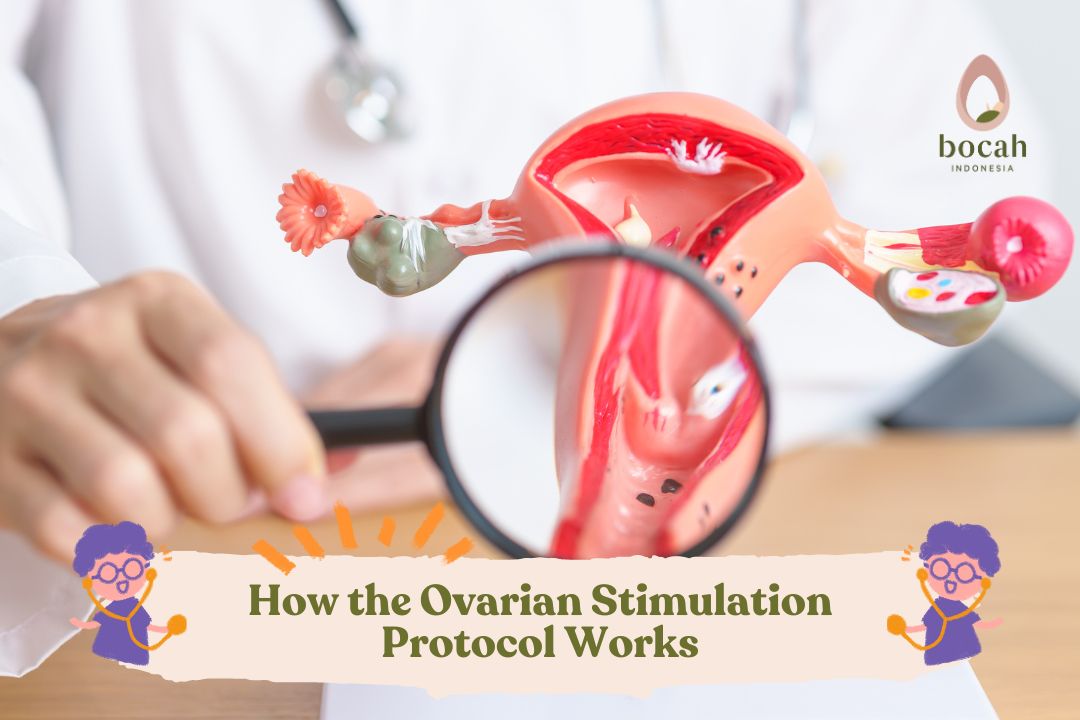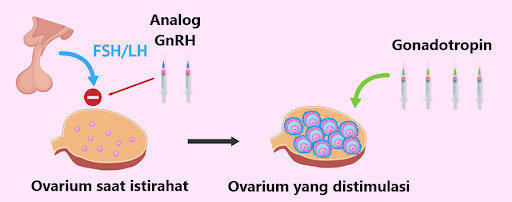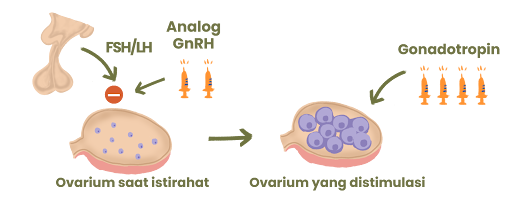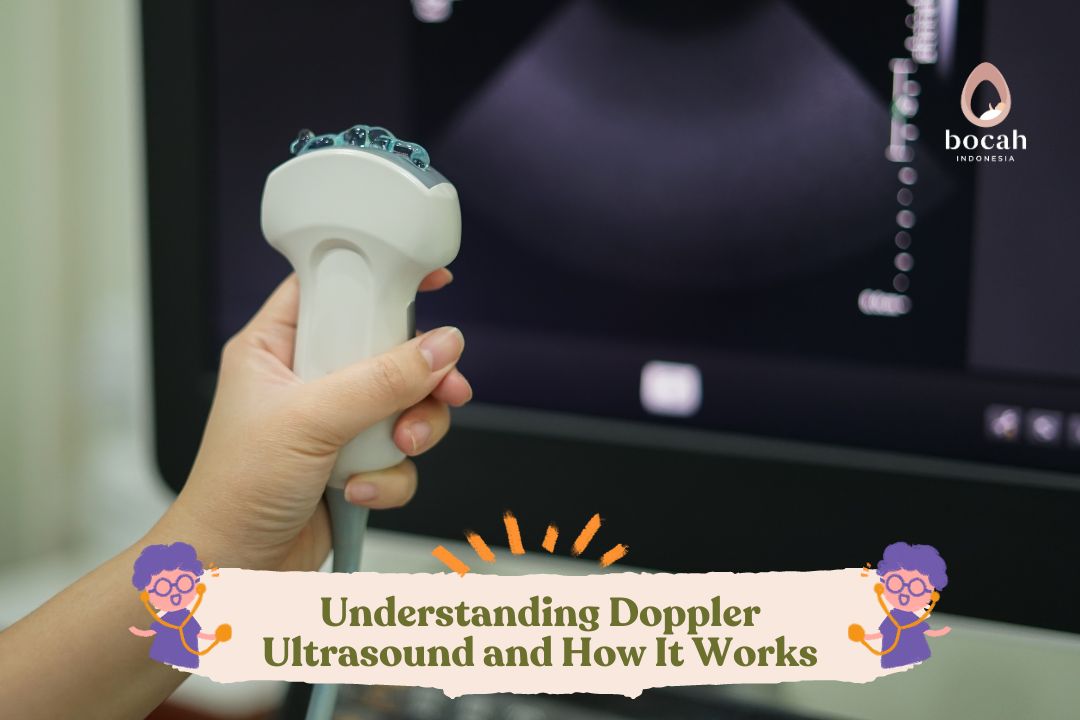How the Ovarian Stimulation Protocol Works

Ovarian stimulation aims to increase a woman’s chances of achieving pregnancy.
Ovarian stimulation is the second stage of the in-vitro fertilization (IVF) process. The goal is to “harvest” as many mature eggs as possible from the woman’s ovaries. The more mature eggs that are obtained, the more likely it is that one of those eggs can be fertilized, implanted back into the uterus, and develop into a healthy baby.
Since the natural female reproductive cycle is very complex, ovarian stimulation is also a complicated process. To better understand the process, let’s first look at how the ovaries work.
How do the ovaries work?
Follicles are structures within the ovaries that contain the eggs. In each menstrual cycle, there is a recruitment of follicles that depends on the levels of gonadotropin hormones, particularly FSH (Follicle Stimulating Hormone).
As a result, in each ovarian cycle, only one follicle will be able to develop fully and become the preovulatory follicle. The other follicles will degenerate, and the eggs within them will be lost.
Tanya Mincah tentang Promil?
In the middle of the menstrual cycle, around day 14, there is a surge in another gonadotropin hormone, LH (Luteinizing Hormone). This hormone surge will trigger ovulation. The preovulatory follicle will then rupture, and the egg is released into the fallopian tube. The egg can then be fertilized if there are sperm present.
What is the difference with stimulated ovaries?
Ovarian stimulation aims to mimic the natural ovulation cycle of the body, but on a larger scale. To achieve this, controlled ovarian stimulation is performed, using medications or hormone injections to allow the maturation of multiple follicles to occur simultaneously. This way, the number of harvestable eggs for fertilization is increased. Consequently, the number of embryos obtained and the chances of achieving pregnancy are also increased. It is important to note that ovarian stimulation is a bilateral process, meaning the follicular maturation occurs in both ovaries.
Generally, there are three phases in ovarian stimulation, each marked by the administration of different medications, each with its own specific purpose:
1. Pituitary suppression.
At this stage, GnRH analogue medications are given to suppress the hormonal flow between the pituitary gland and the ovaries. The pituitary function is minimized, preventing the internal production of gonadotropins, namely FSH and LH. This allows the ovaries to be stimulated externally using exogenous hormones.
2. Multiple follicular development.
After the pituitary gland is blocked, exogenous gonadotropins need to be administered. These medications contain FSH, and sometimes LH. The goal is to synchronize the development of multiple follicles, so that many can mature simultaneously.
3. Final maturation and ovulation induction.
The final phase involves the administration of an hCG (human chorionic gonadotropin) injection. This medication triggers the final maturation of the eggs within the follicles and induces the ovulation process.


Ovarian Stimulation Protocols in IVF Currently, there are two main types of ovarian stimulation protocols, namely the long protocol and the short protocol.
- Long protocol: This protocol is considered the conventional process. The stimulation process begins about 1 week before the next menstrual cycle. In women with a 28-day menstrual cycle, the injections start around day 21 of the cycle. GnRH analogues are given first to suppress the natural ovarian function. After the menstrual cycle begins, the woman will start daily injections of gonadotropin hormones and be monitored for the next two weeks, when the eggs are harvested.
- Short protocol: This protocol is also called the antagonist protocol. The process starts when the menstrual cycle begins, with the addition of hormone injections to increase egg maturity, so that more eggs can be retrieved later. This protocol is often used when the long protocol is unsuccessful, in women with polycystic ovarian syndrome, or those with diminished ovarian reserve. The medication used to suppress the pituitary gland function, the GnRH antagonists, have a direct effect after administration. Therefore, fewer injections are required.
The duration of ovarian stimulation depends on many factors, especially how the woman responds to the hormonal medications and whether the follicles develop properly. In general, the phase of multiple follicular development lasts approximately 10 days. However, the total duration of stimulation will depend on the specific protocol determined by the doctor.
Process and Monitoring of Ovarian Stimulation
Hormonal treatment to stimulate the ovaries, namely gonadotropins, should be started on the first few days of the menstrual cycle (between days 1-3 of the cycle). Prior to this, a transvaginal ultrasound (USG) is performed to ensure that the ovaries are at rest, and if so, the stimulation can begin.
The medications for ovarian stimulation are usually administered daily, through subcutaneous (under the skin) injections in the abdominal area. After a few days of use, the woman must visit the doctor to have her follicular development evaluated. Follow-up visits to evaluate follicular development are done about every two days. Each time she visits, the doctor will examine the developing follicles and measure their diameter through ultrasound. Based on the examination results, the doctor may adjust the medication dosage to achieve an optimal ovarian response.
The follicular diameter considered “mature” is between 18-25 mm. In addition, monitoring of estradiol hormone levels through blood tests is also required, which usually range between 200-300 pg/mL per mature follicle.
In an IVF program, after the follicle maturation is achieved, the woman will be informed of the exact time to receive the hCG hormone injection. This hormone will induce ovulation or egg release, which occurs between 24-48 hours afterwards, with an average of 36 hours. Subsequently, egg retrieval (ovum pick-up) is scheduled to “harvest” the mature follicles. While in the artificial insemination process, the egg retrieval step is replaced by the injection of the selected sperm directly into the uterus.
Ovarian Response to Stimulation
Each woman can show a different response to hormonal medications for ovarian stimulation. Therefore, it is common to get different results even with the same stimulation protocol. If a woman is undergoing an IVF program or other assisted reproductive techniques for the first time, it is difficult to know how the ovarian response will be to the stimulation. This will depend on several factors, such as age, ovarian reserve, the dose of hormones given, and so on.
As much as possible, the doctor will try to adjust the stimulation protocol to optimize the ovarian response. However, both the doctor and the couple must be vigilant against two undesirable situations that can occur and must be considered, namely low responder and high responder.
A woman is classified as a low responder if the number of eggs obtained after ovarian stimulation is very low, i.e., less than 4. Conversely, a woman is considered a high responder if the number of mature eggs is >15 and is accompanied by signs of excessive ovarian response to the stimulation medications. One of the risks that must be truly anticipated is ovarian hyperstimulation syndrome (OHSS).
Other Things to Anticipate During Ovarian Stimulation
The ovarian stimulation process requires precise timing and caution. The presence of problems can cause the process to be repeated. This experience can certainly trigger frustration and pessimism in the couple undergoing it. At the same time, this phase can be a time full of hope. Therefore, the couple needs to pay attention to the following:
-
Managing the Medication
Medications for IVF programs are usually complex. As the carrying party, the woman receives a heavier “burden” such as having to inject herself, as well as using hormonal patches or pills. Under this pressure, the risk of forgetting to take or inject the medication certainly exists. If this happens, there is no need to be ashamed or worried, immediately seek help and advice.
After starting to use medications to stimulate the ovaries, women need to undergo serial blood tests to measure hormone levels in the body. Because each woman’s response to this treatment can be different, hormone administration must be adjusted daily to ensure that enough follicles are stimulated, and at the same time, to reduce the risk of OHSS.
-
The Need for Regular Checkups and Follow-up Visits
Blood tests and follow-up visits to the doctor need to be done regularly according to the schedule. Therefore, it is important to choose a trusted, communicative medical team that can provide timely reminders.
-
Stress and Mood Swings
Considering the many “demands and pressures” of the ovarian stimulation process, it is natural for women to often experience stress and mood changes. Mood swings can be a combination of hormonal changes in the body and stress from the treatment process, which are difficult to separate.
-
Complications and Side Effects
In addition to stress and worry, the ovarian stimulation process can cause physical side effects due to medication and hormone injections. Mild side effects can include rashes or swelling at the injection site. Some women may experience pain around the breast area, bloating, and abdominal pain. Because ovarian stimulation causes many eggs to develop at the same time, there is a possibility that more than one egg will be fertilized. As a result, multiple pregnancies can occur, which have their own risks, such as premature birth or even miscarriage. However, the side effect that must be most anticipated is ovarian hyperstimulation syndrome. In this condition, the ovaries become enlarged, the abdomen becomes swollen and painful, and it can lead to kidney damage, chest pain, and shortness of breath.
Conclusion
Ovarian stimulation is one of the most difficult parts of the IVF program. So, if you are considering undergoing it, make sure to choose a trusted and reliable medical team. If you are unsure about many things, do not hesitate to ask questions and continue to monitor the treatment to ensure optimal results.
Finally, remember that this series of processes can be stressful for you. Therefore, pray often and communicate with your partner about everything. Don’t forget to be gentle with yourself and don’t push yourself too hard.
This article has been medically reviewed by Dr. Fiona Amelia, MPH
Source:
- American Society of Reproductive Medicine. (Revisi 2014). Ovarian hyperstimulation syndrome (OHSS). URL: https://www.reproductivefacts.org/news-and-publications/patient-fact-sheets-and-booklets/documents/fact-sheets-and-info-booklets/ovarian-hyperstimulation-syndrome-ohss/.
- ESHRE Guideline Group on Ovarian Stimulation, Bosch E, Broer S, Griesinger G, Grynberg M, Humaidan P, Kolibianakis E, Kunicki M, La Marca A, Lainas G, Le Clef N. ESHRE guideline: ovarian stimulation for IVF/ICSI. Human reproduction open. 2020;2020(2):hoaa009.
- Fauser B. Patient education: Infertility treatment with gonadotropins (beyond the basics). In: UpToDate, Post, TW (Ed), UpToDate, Waltham, MA, 2024.
- Ho J. In vitro fertilization: procedure. In: UpToDate, Post, TW (Ed), UpToDate, Waltham, MA, 2024.



